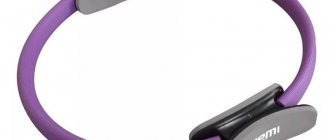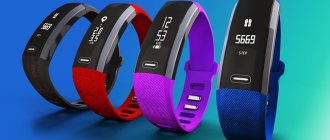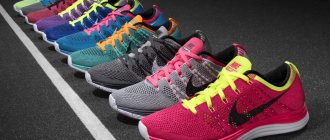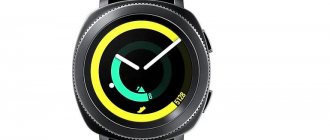A sports device that shows heart rate with the ability to track maximum heart rate, calorie burning, exercise period and distance traveled is a chest-mounted heart rate monitor. The working element is worn on the body, the pulse signal is transported to the screen of the wrist watch. Models from different manufacturers differ in color, shape and functionality.
Why a chest heart rate monitor and not a smart watch or bracelet?
A heart rate monitor is a device that measures a person’s heart rate in real time. It is used during training and is necessary for practicing various sports disciplines:
- crossfit;
- fitness;
- power training;
- martial arts;
- run;
- skis;
- other sports.
In this case, preference should be given to the chest device. There are three main reasons for this.
- The chest heart rate monitor does not interfere with exercise. For example, a smartwatch bracelet with the function of measuring heart rate and other biometric parameters of the human body can get caught on projectiles during training with free weights or cause injury during martial arts training.
- Reliability. We have already said that the gadget can get caught on sports equipment. During such engagement it may break. But this is very often an expensive thing. A device designed to be attached to the chest is much less likely to fail during training.
- More accurate readings. The watch's heart rate sensors are located on the wrist. It is far enough away from the heart that not every heartbeat can be read by the device. Chest devices are attached to the chest, that is, in close proximity to the heart muscle. This allows them to accurately and timely read all its abbreviations and not distort the information.
Chest heart rate monitors are usually cheaper than smartwatches because they do not have any additional functions such as receiving calls on a smartphone or viewing SMS messages. They are designed for one single purpose: accurate heart rate measurement.
What should you pay attention to when choosing a device? Here are a few main parameters.
- Functional. The simplest devices can only measure your pulse. More sophisticated ones can be connected via Bluetooth to a smartphone, configured through a special application, and keep statistics of your sports activities.
- Convenience. It is important that the purchased gadget is ergonomic and that it is convenient to use. Otherwise, you will experience discomfort during training and will not fully enjoy it.
- Manufacturer. Today, the market offers both devices from famous brands and nameless Chinese products. Let’s say right away that there is no big difference between them. All gadgets cope with their tasks equally well. True, in a number of cases, the “Chinese” may differ in slightly lower quality.
- Price. The optimal choice is a device in the mid-price category. On the one hand, it will not have an inflated price due to “branding” and will not require overpayment. On the other hand, you can be sure of acceptable quality and sufficient reliability.
Purpose of the device
For those who regularly attend training or run, an indispensable attribute of sports activities is a heart rate monitor. The function of the meter is to show at what frequency the athlete’s heart contracts during cardio exercise. The device detects your pulse and records it for future research.
The monitor is necessary, first of all, for people who have chosen the following sports to train their bodies:
- Athletics;
- ski racing;
- skating;
- bicycle;
- swimming.
The above list requires constant monitoring of the rhythm of a vital organ, since the heart receives a strong load when performing specific movements.
Knowing the norms of contractions at rest and during exercise, you can see how this vital organ reacts to body movements. The first heart rate monitor, invented four decades ago, is primitive compared to modern options. In 1977, an electrocardiographic monitor was invented for the Finnish national cross-country skiing team. At first it was used as a teaching aid in classes to see how the skier’s heart muscle works when performing the trainer’s tasks.
Initially, the device was a box with two electrodes that were attached to the human chest.
During exercise, it is important to control the number of heart beats per minute. The owner of the heart rate monitor is notified by a sound signal about how to adjust the pace of body movements. It is increased if the heart is working normally, or decreased when it has become difficult for a vital organ to cope with its function.
After the quality of its work was appreciated by many people involved in sports, the heart rate monitor was launched on sale to everyone. This happened in 1983.
DFC W227Q
DFC W227Q is a compact, simple Chinese-made heart rate monitor without additional functions. The device is inexpensive - from 3,000 to 4,000 rubles. A distinctive feature of this model is its fairly high measurement accuracy: the statistical measurement error of the DFC W227Q is close to zero.
The DFC W227Q runs on a CR3032 battery. The gadget can be connected to a smartphone or tablet using the built-in Bluetooth module to control it via a mobile application. The application allows you to view the device readings in real time, as well as record them and store them in the cell phone’s memory. This is very convenient for trainers: they can monitor the athlete’s performance directly during his training and stop training in a timely manner in case of health risks.
The DFC W227Q is secured to the torso with an adjustable elastic strap. The adjustment is quite wide - the device is suitable for those with a torso with a diameter of 60 to 105 centimeters. This makes the DFC W227Q suitable for use by both men, women or teenagers.
Low cost and reliability made the DFC W227Q popular and provided it with good user reviews.
DFC W227Q
Comparison table of characteristics
| Wahoo Fitness Tickr X | Garmin Hrm Tri | Suunto Smart Belt | Polar H10 | MyZone MZ-3 | |
| Battery | Replaceable CR2032 battery | Replaceable CR2032 battery | Replaceable CR2025 battery | Replaceable CR2032 battery | USB, lithium battery |
| Battery life | Up to 12 months | 10 months (three workouts 1 hour per day) | Up to 500 hours | Up to 400 h | 7 months of battery life per charge |
| Water resistance | IPX7 (waterproof up to 10 ATM) | 5 ATM (50 m) | 3 ATM (30 m) | 3 ATM (30 m) | |
| Sensor | Heart rate sensor, accelerometer | Heart rate sensor, accelerometer | Heart rate sensor | Heart rate sensor | Heart rate sensor |
| Connection | Bluetooth 4.0 and ANT+ (dual band technology) | ANT+ | Bluetooth | Bluetooth (supports simultaneous connections) | Bluetooth, ANT+ |
| Internal storage | Up to 16 hours of workout data | Yes. Up to 3 hours of workout data | Yes. Up to 16 hours of workout data | ||
| Heart rate | |||||
| Heart rate variability | |||||
| Tracking | Calories, vertical oscillation and ground contact time | Cadence, stride length, ground contact time, ground contact time balance, vertical oscillation and vertical ratio | Real-time heart rate and calories burned data | Monitors heart rate with multiple target zones, as well as calories burned, steps taken and distance | Monitors heart rate, calories and time |
| Swimming statistics | Heartbeat | Heartbeat | Heart rate | Sends heart rate information while swimming to devices that support 5 kHz transmission | No |
| Peculiarities | Works with apps like RunFit 7-Minute Workout and more Tracks cadence while cycling when paired with the Wahoo Fitness app | Specially designed for triathletes | Indoor Gym Compatible GoPro Connectivity Lets you choose your favorite activity from over 100 sport profiles and get real-time voice guidance during your workout | Live data display via mobile app, watch or gym equipment Online log with goal setting, biometrics, tasks, status and social channels |
Remember: If you have any concerns about your health or fitness level, consult your physician. And it's always a good idea to consult with a personal trainer when developing exercises and goals. Take care of yourself.
- Was the information useful?
- No
Garmin HRM-Tri
Garmin HRM-Tri is a more advanced device, which is also produced in China. Unlike the previous participant in our rating, it is waterproof, which allows it to be used during swimming.
In addition to heart rate, Garmin HRM-Tri measures a number of other characteristics:
- time of contact with the ground when running;
- vertical vibrations.
The device also connects to a smartphone. The ANT+ wireless protocol is used for this. However, this model does not need a smartphone to record statistics - it has its own built-in memory. It stores all reports of body performance during exercise over the past few days. You can access them using your smartphone or tablet.
Nuances of use
If you bought the simplest device with a watch receiver, all you need to do is attach the sensor to your chest and put the receiver on your hand. After this, your heart rate will immediately appear on the screen. You will also need to set the date and time and make other necessary settings.
If your receiver is a cycling computer, GPS navigator or smartphone, setup may take a little longer - in this case you will also need to establish a connection between the receiver and the sensor.
SUUNTO Smart Sensor
SUUNTO is a well-known Finnish company that produces various products for athletes, tourists and travelers under its own brand. Among its products are heart rate monitors. One of them is SUUNTO Smart Sensor. It is simple, convenient and practical. SUUNTO Smart Sensor does not have any additional functions - it only measures heart rate, and does it quite accurately.
You can find out the heart rate monitor readings in two ways:
- by connecting it via Bluetooth to a proprietary mobile application developed by SUUNTO;
- by connecting the gadget via Bluetooth to a SUUNTO sports smartwatch.
SUUNTO Smart Sensor is available in several variations. They differ in the size of the chest strap. This allows the model to be used by people of different genders, ages, and builds.
SUUNTO Smart Sensor
Rating of heart rate monitors for running
So, our review includes both a budget heart rate monitor for running and a device from the more expensive segment - we hope our selection will be useful to everyone interested. According to Yandex Market data, the most popular brands today are Garmin, Polar, Beurer, Sigma and Suunto. Here are the models included in our review of heart rate monitors for running:
Beurer PM25
Beurer PM25 – 2650 rub. This is a wrist device with moisture protection that can count calories, the amount of fat burned, calculates the average heart rate, controls the heart rate zone, and includes a stopwatch and watch. Users praise its accuracy, reliability and stylish appearance. Among the shortcomings, they noted that the glass of the model is easily scratched.
Suunto Smart Sensor
Suunto Smart Sensor – 2206 rub. Chest model with a built-in heart rate sensor, attached to the chest using a belt. Connects to a smartphone based on Android and IOS, has a moisture protection and calorie counting function. On the plus side, people noted its accuracy, small size and low cost. But among the disadvantages, they highlighted that the strap is too hard and puts pressure on the chest, and also that the battery drains quickly.
Sigma PC 10.11
Sigma PC 10.11 – 3200 rub. A wrist device with all sorts of built-in options. It looks very elegant and neat. Among its advantages are simple and intuitive settings, connection to a smartphone, exercise equipment, accurate readings, and pleasant alarm sounds. Cons: instructions in English, strap and bracelet leave marks on the wrist.
Polar H10 M-XXL
Polar H10 M-XXL – 5590 rub. This model is included in our top heart rate monitors for running due to the huge number of positive reviews. The chest strap is equipped with all the options available today that can be inserted into a heart rate monitor. Not a single buyer has denied its high accuracy. Everyone writes that the device is worth the money. Its main advantages are a well-known brand, ease of wearing, accuracy, holds a charge for a long time, and connects to all devices (smartphones, watches, exercise equipment). Disadvantages - over time you will need to change the strap, and it is expensive (half the cost of the gadget itself).
Garmin HRM Tri
Our top review rounds out the Garmin HRM Tri running heart rate monitor – RUB 8,500. Chest strap, waterproof, reliable, accurate, stylish. The strap is made of textile, does not press and does not interfere with running. Its advantages are that it is indeed a very good and accurate device, which one hundred percent justifies all its characteristics. The downside is the price tag, which is higher than average. However, there are devices that are twice as expensive.
Well, our article has come to an end, we hope the material turned out to be clear and comprehensive. Play sports safely!
Wahoo TICKR
The Wahoo TICKR is an inexpensive heart rate monitor that can be strapped to your chest, wrapped around your torso, or slung over your shoulder. The device is simple and does not have an excess of functions. It allows you to track three indicators of the human body:
- heart rate;
- analytics of movements made during classes;
- training intensity level.
The model does not have its own interface (it is limited to two LEDs that indicate whether the device is on or off). You can receive data from the gadget by connecting the device to a mobile phone or tablet using Bluetooth or ANT+ wireless protocols.
Wahoo TICKR
Additional functions
Standard additional features of chest heart rate monitors include:
- watch;
- timer and stopwatch - a useful function when playing sports;
- pedometer;
- the ability to set the required pulse zone - you can specify the lower and upper limits of the required pulse corridor, when leaving it the device will sound a sound signal;
- maintaining training statistics;
- body mass index calculator;
- burnt calories calculator;
- measurement of breathing intensity and frequency.
For more useful information about choosing the right device, watch the video:
REEBOK Pulse Steel RD-PUL-G0
REEBOK Pulse Steel RD-PUL-G0 is a chest-mounted heart rate monitor from a world-famous British company producing sportswear and equipment for those who play sports.
This heart rate monitor model includes a chest strap and a special electronic watch. There is no provision for connecting the device to a smartphone - all the necessary information is displayed on the display of the watch, which connects to the sensor via Bluetooth.
The REEBOK Pulse Steel RD-PUL-G0 has an alarm that goes off when the athlete's heart rate increases too much. The clock signals this.
An additional function of the REEBOK Pulse Steel RD-PUL-G0 is a stopwatch. This model has no other functions. The watch can be used without a sensor - for its intended purpose. It has a case of durable shockproof plastic, as well as water resistance of 100 atmospheres, which allows you to swim in it.
RESULT
Both solutions can serve as excellent heart rate monitoring tools. What exactly to choose depends largely on the individual goals, experience, and level of training of the user. Below we offer several typical situations in which our clients chose a chest or optical heart rate monitor.
Choosing a chest heart rate monitor:
- Just started playing sports and want to monitor your heart rate. You don't want to spend a lot of money at the initial stage. There is a smartphone with which you can synchronize a heart rate monitor (anyone with Bluetooth and the ability to install a mobile sports application will do);
- There are sports watches, but they do not have a heart rate sensor;
- There are watches with an optical heart rate monitor, but they lack accuracy during high-intensity training (interval running);
- Are you planning to seriously engage in running or skiing?
Polar H10 M-XXL
Polar H10 M-XXL is a professional heart rate monitor for sports with the ability to determine additional parameters of the human body. A distinctive feature of this model is its extreme convenience. If an athlete wears Polar H10 M-XXL, he simply does not notice it. The manufacturer managed to achieve such comfort thanks to an ergonomic adjustable belt made of soft and elastic polymer material.
In addition to heart rate, Polar H10 M-XXL calculates the total amount of fat consumed during training in grams.
The device does not have its own interface. You can access the information collected with its help by connecting the gadget to a mobile phone or tablet via Bluetooth and ANT+ wireless protocols.
Polar H10 M-XXL has built-in memory. This saves the athlete from the need to constantly record their performance in the smartphone’s memory and from constantly connecting the device to the mobile phone - they can exercise without connecting to a phone, and the data can be viewed after training.
Polar H10 M-XXL is considered one of the most accurate heart rate monitors. The device’s sensors read heartbeats in a timely manner, and the device’s software calculates their frequency without errors.
It should be noted that Polar H10 M-XXL has become the choice of many professional athletes and coaches.
The average price of this heart rate monitor model in Russian stores is only 7,000 rubles, which is quite a bit for a device equipped with such precise sensors.
Polar H10 M-XXL
How does a heart rate monitor work in a sports watch?
At a time when medicine did not have modern technical diagnostic tools, the pulse was measured by placing a finger on the artery and counting the number of pushes of the artery wall through the skin over a certain period of time - usually 30 seconds or one minute. This is where the name of this effect comes from - pulsus (Latin for “blow”), measured in beats per minute.
There are many methods for determining the pulse, but the most famous are feeling the pulse on the wrist, on the neck, and in the area of the carotid artery.
After the advent of the electrocardiograph (ECG), the pulse began to be calculated from the signal of the electrical activity of the heart, measuring the duration of the interval (in seconds) between adjacent R waves on the ECG, and then converting it into “beats per minute” using a simple formula: heart rate = 60/(RR- interval).
An electrocardiogram can tell a lot about our heart besides the pulse, but taking and interpreting an ECG requires equipment and a cardiologist, which you can’t take with you on a run. Fortunately, in the modern world, almost everyone can afford a heart rate monitor that will determine your heart rate while running and at rest.
How does a heart rate monitor work?
Pulse measurement using electrocardiosignal
The electrical activity of the heart was discovered and described at the end of the 19th century, and already in 1902 Willem Einthoven became the first to technically record it using a string galvanometer.
In addition, Einthoven was the first to record an electrocardiogram (he himself gave it that name), developed a lead system and introduced the names of the cardiogram segments. For his work, he received the Nobel Prize in 1924.
In modern clinical practice, various lead systems (that is, electrode attachment schemes) are used to record ECGs: from the limbs, chest leads in various configurations, etc.
In order to measure the pulse, you can use any leads - based on this principle, sports watches have been developed that can determine heart rate.
Early models of heart rate monitors consisted of a box (monitor) and wires attached to the chest. The first wireless ECG monitor was invented in 1977, and became an indispensable assistant in the training of the Finnish cross-country skiing team. The first wireless heart rate monitors went on mass sale in 1983, since then they have firmly occupied their niche in amateur and professional sports.
When designing modern sports gadgets, the lead system was simplified to two electrode points, and the most famous version of this approach was sports chest sensors in the form of a strap (HRM strap/HRM band).
To obtain a stable and high-quality signal, it is necessary to moisten the “electrodes” on the chest strap with water.
In such straps, the electrodes are made in the form of two strips of conductive material. The strap can be part of the entire device or attached to it with clasps. Heart rate values are usually transmitted via Bluetooth to a sports watch or smartphone using the ANT+ or Smart protocol.
Pulse measurement using optical plethysmography
Now this is the most common method of measuring heart rate in terms of mass application, implemented in sports watches, trackers, and mobile phones. And the first attempts to use this technology were made back in the 1800s.
The narrowing and expansion of the vessel under the influence of blood flow pulsation causes a corresponding change in the amplitude of the signal received from the output of the photodetector.
The method is widely used in hospitals; later the technology was transferred to household devices - compact pulse oximeters that record pulse and blood oxygen saturation in the capillaries of the finger. Great for periodic heart rate measurements, but not at all suitable for constant wear.
Heart rate monitors
The idea of measuring heart rate from an athlete's wrist using optical plethysmography without wearing a chest strap was very attractive. This idea was first implemented in the Mio Alpha watch, which proclaimed its device a breakthrough and a new revolution in heart rate measurement. The measurement sensor module itself was developed by Philips.
Optical technology measures heart rate using LEDs that evaluate blood flow at the wrist. This means you can measure your heart rate without using a chest strap. In practice, it works like this: an optical sensor on the back of the watch emits light onto the wrist using LEDs, and measures the amount of light scattered by the bloodstream.
Pulse recording method for photoplethysmographic sensors
For pulse measurement, the area with maximum absorption is important - this is the range from 500 to 600 nm. Typically 525 nm (green) is selected. The green LED of the pulse sensor is the most popular option in smart watches and bracelets.
Now this technology is well developed and introduced into mass production. The range of emerging devices with similar technology is quite wide (smartphones, tracker bracelets, watches), and manufacturers of sports devices are also not lagging behind - all the most significant companies are expanding their line of heart rate monitors with models with optical sensors.
Errors in the operation of optical sensors
It is believed that optical sensors accurately determine heart rate when walking and running. However, as the heart rate increases to, say, 160 bpm, blood flow passes through the sensor area so quickly that the measurements become less accurate.
In addition, in the wrist, where there is not much tissue but a lot of bone, ligaments and tendons, any decrease in blood flow (for example, in cold weather) can interfere with the operation of the optical heart rate sensor.
One small study compared the accuracy of chest strap and optical heart rate monitors. The subjects were divided into two groups, in one group the pulse was measured using a chest sensor, and in the other - using an optical sensor. Both groups were tested on a treadmill, where they first walked and then ran, while their heart rate was recorded. In the group with a chest strap, the accuracy of heart rate measurement was 91%, while in the group with an optical sensor it was only 85%.
According to the head of Mio Global, currently none of the heart rate monitor sensors compares accurately with the chest strap.
We must not forget about specific situations when the optical sensor may not work. A watch worn over a running jacket, a tattoo on the wrist, a watch that does not fit tightly to the skin, or working out at the gym - all this can lead to errors in measuring heart rate using optical sensors.
Despite this, technological advances in heart rate measurement have resulted in a useful alternative to chest straps, and by addressing some of the shortcomings of optical sensors, we will have another powerful and accurate tool for monitoring heart rate during sports.
What running indicators can you get from a heart rate monitor?
Strictly speaking, advanced running dynamics are measured while wearing a chest strap. Externally ordinary, inside the sensor consists of a transmitter and an accelerometer, thanks to which the runner’s movement is analyzed. The same accelerometers are found in phones, footpods, and tracker bracelets.
Advanced running metrics include three metrics: ground contact time, vertical oscillation, and cadence.
Ground contact time (GCT)
shows how long your foot is on the ground during each step. Measured in milliseconds. A typical amateur runner spends 160-300 milliseconds in contact with the surface. When running speed increases, the GCT value shortens, and when it slows down, it increases.
There is a relationship between ground contact time and the incidence of injury and muscle imbalance in a runner. Reducing ground contact time reduces the incidence of injury. One of the most effective ways to reduce this indicator is to shorten your stride (increase your cadence), strengthen your gluteal muscles, and include short sprints in your training program.
Vertical oscillation (VO).
Look at any professional runner and you will see that the upper half of their torso makes very little movement, while the main work of moving the runner is done by the legs.
Vertical oscillation determines how much your upper half “bounces” when you run. These bounces are measured in centimeters relative to some fixed point (in the case of a chest strap, this is a sensor built into the chest strap). It is believed that the most economical running technique involves minimal vertical oscillations, and a decrease in vertical oscillations is achieved by increasing cadence.
Step frequency or cadence.
As the name of the indicator suggests, it shows the number of steps per minute. A fairly important parameter that evaluates running efficiency. The faster you run, the higher the cadence. It is believed that a frequency of about 180 steps per minute is optimal for efficient and economical running.
Heart rate zones.
Knowing your maximum heart rate, various running watches can break down your workout into heart rate zones, showing how much time you spent in each zone during your workout.
Different manufacturers designate these zones differently, but they can be divided into the following types:
- recovery zone (60% of maximum heart rate),
- endurance training zone (65%-70% of maximum heart rate),
- aerobic capacity training zone (75-82% of maximum heart rate),
- PANO zone (82-89% of maximum heart rate),
- zone of maximum aerobic load (89-94% of maximum heart rate).
Knowing your heart rate zones will help you get the most out of every workout. We will talk about heart rate training in detail in the next article in this section.
In addition to advanced running characteristics, modern heart rate monitors can measure and track several other interesting indicators:
EPOC (excess post-exercise oxygen consumption).
Post-exercise oxygen consumption shows how much your metabolism has changed after a run. We all know that running burns calories, but even after the workout is over, calories continue to be burned. Of course, to replenish them, you need to recover well.
Monitoring your EPOC can help you understand which workouts are the most energy-intensive and can help you improve your recovery.
Calculated oxygen consumption (est. VO2).
An indicator of current oxygen consumption, calculated based on maximum oxygen consumption (
VO2max
) and maximum heart rate.
Maximum oxygen consumption (VO2max).
The indicator reflects your body's ability to consume oxygen. This is important because when this indicator increases, your body can better and faster utilize the oxygen delivered to working muscles.
The value of maximum oxygen consumption (VO2) increases with increasing training. This is one of the most important running indicators and is directly related to running economy. As with determining maximum heart rate, the best way to determine VO2 max is through laboratory testing, but a number of heart rate monitor manufacturers use algorithms for calculating VO2 max with acceptable accuracy. Training helps improve the values of this indicator.
Running performance.
A metric that uses VO2max (the global standard for aerobic fitness and endurance) to track training progress.
Peak training effect (PTE).
Shows the effect of a training session on overall endurance and aerobic performance. The fitter you are, the harder you should train in order to achieve higher PTE numbers.
Instead of output
When used intensively, a heart rate monitor can be a great assistant for a runner. It is extremely wrong to consider a heart rate monitor an expensive toy, which is completely unnecessary for “serious” athletes. Decide on your goals for the season, and then start building a training plan.
Remember that measuring and monitoring your heart rate during training is a reliable way to improve your results and avoid overtraining.
For those who are just starting their running journey, we can recommend first monitoring your heart rate during easy runs, and only then moving on to any training plan. The data obtained using a heart rate monitor will help you understand how your body reacts to stress.
However, there is no need to become a hostage to numbers and gadgets. Learn to listen to your body, evaluate the sensations from each workout, and the numbers will become an important additional source of information.
Author of the article: Evgeniy Suborov
Argument No. 4: ease of use
A special feature of running in winter is the presence of several layers of clothing. Sports watches are also usually attached over the sleeve to prevent cold wrists. In this regard, the built-in optical heart rate monitors will no longer work.
The Polar H10 chest heart rate monitor attaches to the body under clothing and does not disturb you while jogging. A comfortable strap supports the sensor, and silicone knurling will prevent it from slipping to the lower back even during intense workouts.
There are people who compare a chest strap to a women's bra











